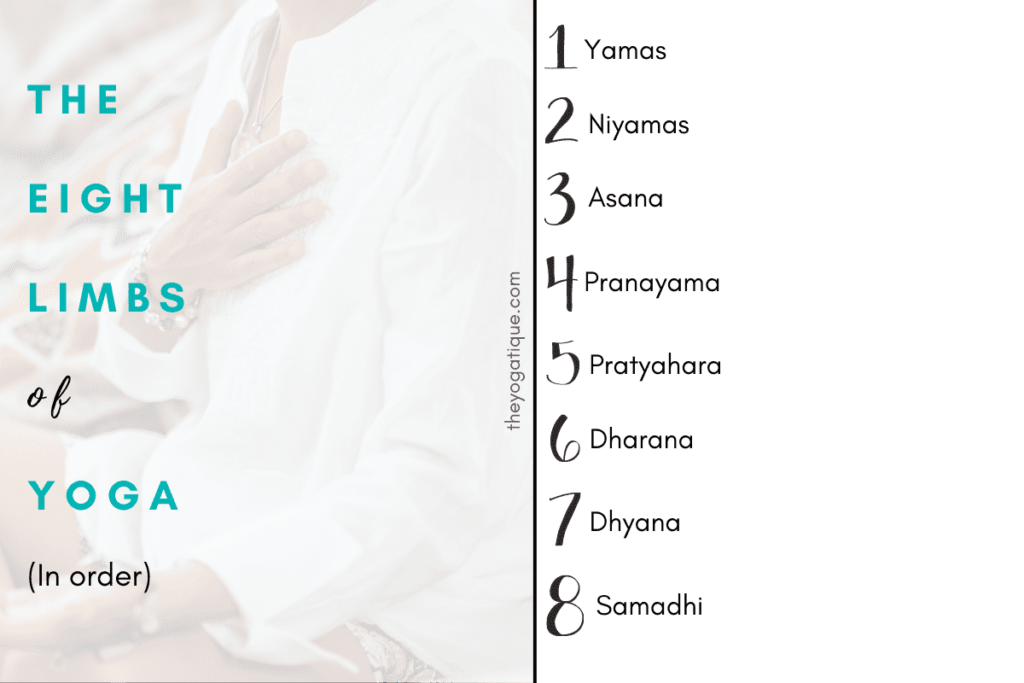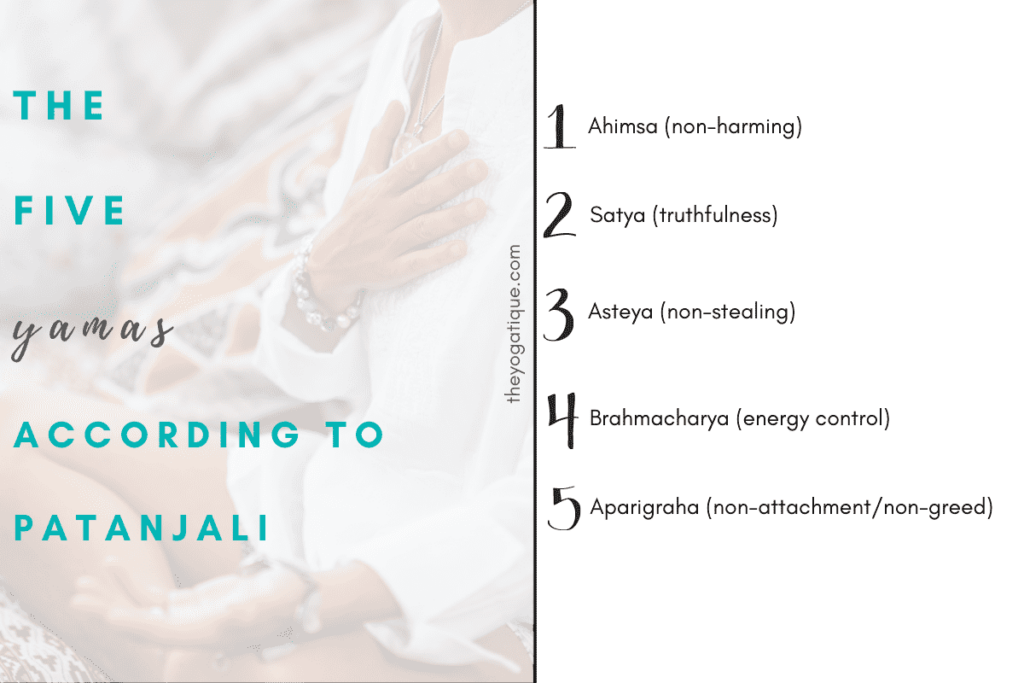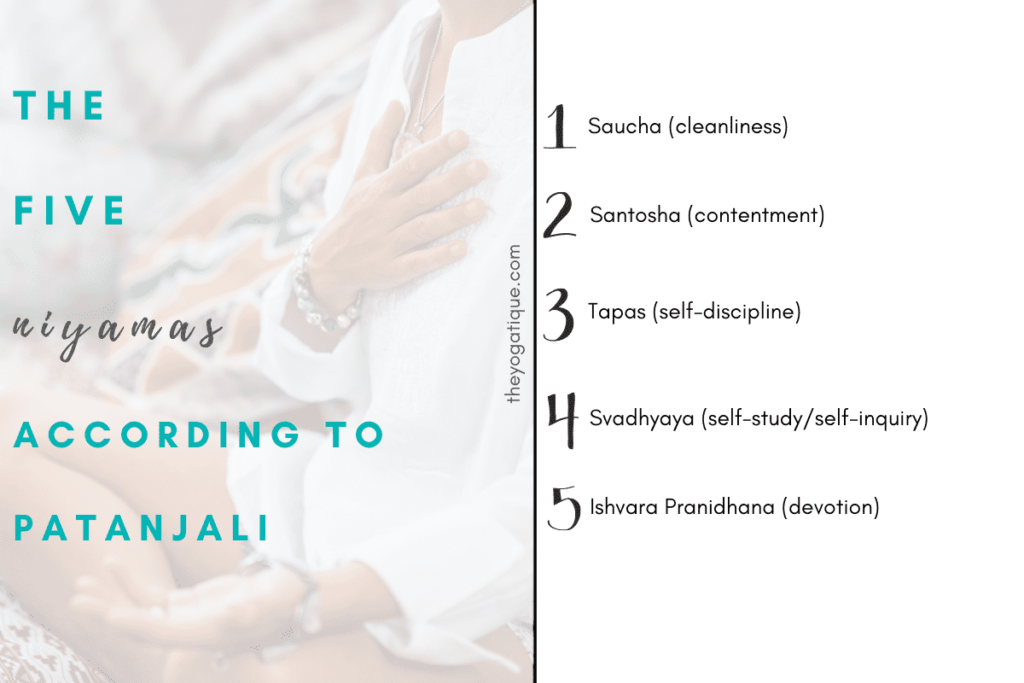
If you've been practicing yoga for a while, you likely know yoga is more than building up a sweat and becoming flexible. But did you know yoga also involves caring for nature, refraining from speaking badly about people, and cleansing your body and mind through clean food and positive thoughts? These are just some of the moral disciplines, also known as the yama and niyama. But what is the meaning of the yamas? It this article, you'll learn about these yogic principles that date back to the 2nd century BCE!
So contrary to popular belief, yoga does not exist in your life solely to make you feel more calm, centered, and ready to take on the world! This practice is actually much deeper than that.
If you're seeking a more profound yoga experience and want to learn how to practice yoga more authentically and traditionally, this article is for you.
Read on to learn about one of the most integral parts of yoga philosophy, the yamas and niyamas, and discover how to incorporate these ancient teachings into your own life.
Article content:
(Click any link below to jump directly to section)
The meaning of the yama and niyama according to yoga philosophy
Difference between yamas and niyamas
List of the 10 yamas and niyamas according to the yoga sutras
The five yamas of yoga in order
The five niyamas of yoga in order
Benefits of incorporating the yamas & niyamas into your life
Takeaway on yama niyama meaning
FAQ about the meaning of the yama & niyama

THE YOGA TEACHER TRAINING
YOU'VE BEEN LOOKING FOR.
Online Yoga Teacher Training Offers
- Affordability
- Flexibility
- Certification
- Lifetime access
⬇Click below to discover the best Yoga Alliance registered yoga teacher training online⬇
The meaning of the yama and niyama according to yoga philosophy
I believe the best explanation of the yamas and niyamas is ‘moral codes' or suggestions on ‘right living.' Some yogis refer to them as the ‘ten commandments of yoga,' but I find this makes yoga seem like a religion, which it is not.
The yamas and niyamas are a significant part of yoga philosophy, introduced by Patanjali in the ancient text “The Yoga Sutras“, part of the Eight Limbs of Ashtanga yoga.
As moral principles, the eightfold path is not a strict requirement every yogi must follow. Many yogis get all the benefits they seek from the physical practice of yoga and do not desire to cultivate a spiritual practice – and that is fine.
For me, the yamas and niyamas are a guiding beacon to making the most compassionate and ethical choices in my life.
The Eight Limbs of Yoga

- Yama (moral disciplines)
- Niyama (personal observances)
- Asana (yoga postures)
- Pranayama (breath control)
- Pratyahara (withdrawal of the senses)
- Dharana (concentration)
- Dhyana (meditation)
- Samadhi (connection with the divine)
Differences between the yamas and niyamas
You can think of the yamas as the things you should avoid doing in life. For example, you should avoid harming others and stealing from others. While the Niyamas represent the things you should do. For example, you should keep clean (body, mind, spirit), you should seek contentment over certain other emotions, especially.
Yama English translation
The Sanskrit word Yama translates to “restraint,” suggesting things we should avoid doing.
The yamas are external, serving as guidelines for interacting with others and the outside world, including animals and the environment.
Niyama English translation
The Sanskrit word Niyama translates to “observances” or “positive duties,” meaning good habits for healthy living and fulfilling spiritual existence.
The niyamas resemble how we should act towards ourselves, so they are internal ethics.
List of the 10 yamas and niyamas according to the Yoga Sutras

There are 10 yamas and niyamas in total (5 yamas and 5 niyamas). They also come in a specific order or relevance or importance. The original Sanskrit Yoga Sutras of Patanjali suggests that the first yama has more importance than the other four, and the same for the first niyama.
Let's look at each yama and niyama and how to apply them on the yoga mat and in everyday life.
The five yamas of yoga in order

1. Ahimsa (non-violence/non-harming)
The first moral code, Ahimsa, does not only mean not harming others physically. Non-violence includes being mindful of your thoughts and words, as these can hurt others and also others. Many modern-day prominent yoga teachers also view Ahimsa as non-harming to animals by following a vegan or vegetarian lifestyle.
2. Satya (truthfulness)
Aside from not telling lies, Satya requires being honest with others (and ourselves) about our thoughts and feelings. Satya suggests that honesty is the best policy.
3. Asteya (non-stealing)
Of course, we should never steal physical possessions, but Asteya also means not stealing time or energy from others. Non-stealing also relates to not taking from the earth what is not ours.
4. Brahmacharya (abstinence)
Brahmacharya is best described as using your sexual energy (the most potent form of energy) correctly. For example, being promiscuous could be seen as wasting it, which moves you further away from your highest power.
5. Aparigraha (non-possessiveness/non-hoarding)
This moral discipline is about not being greedy or taking more than you need. In modern times this can be a vital self-reflection practice to consider if your consumption harms the earth and what steps you can take to reduce your consumption.
The five niyamas of yoga in order

1. Saucha (cleanliness)
Beyond physical hygiene, saucha is about cultivating cleanliness in your mind by creating a mind space of pure and positive thoughts. Saucha is also about caring for your body by eating clean food and exercising regularly to remove toxins.
2. Santosha (contentment)
Santosha reminds us to focus on gratitude for what we already have rather than always striving for more. The yoga sutra for santosha translates as “through contentment, unsurpassed joy is gained.”
3. Tapas (self-discipline)
Tapas refers to the heat that builds up inside us during periods of determined effort. It reminds us that by practicing self-discipline, we can achieve our goals.
4. Svadhyaya (self-study/self-inquiry)
Self-study is about continuously reflecting on or studying ourselves, which can be through meditation, reading yogic scriptures, or other spiritual practices.
5. Ishvara Pranidhana (devotion)
The last niyama means contemplation of a higher power and understanding there is something greater than ourselves.
↓Great Yoga Alliance certified yoga teacher trainings you should look into↓
Benefits of incorporating the yamas & niyamas of yoga into your life
So why should yoga teachers and practitioners follow the yamas and niyamas? The belief is that mastering these first two limbs of yoga allows you to advance to the higher limbs, bringing you to the ultimate goal of the yogic or spiritual path; self-realization.
But what if your goal of practicing yoga is not to become enlightened? Should you still practice these two limbs?
Absolutely. There are many benefits to following the niyamas and yamas, including:
1. Cultivating a more holistic yoga practice
Many modern-day yogis solely practice asana (yoga postures) in yoga class, which is only one of the Eight Limbs Of Yoga. So to experience the greatest benefits from yoga, you should practice all the limbs, not just asana. What's more, as asana comes after both yama and niyama in the sutras, it suggests that practicing yoga off the mat is more important than practicing on it!
2. Increasing your spiritual connection
Practicing classical yoga means living yoga in your daily life rather than just practicing it in physical exercise. Doing this deepens your experience as you cultivate a spiritual practice, like meditation, alongside a physical one during your life’s journey.
By introducing more of the Eight Limbs to your life, you will develop a stronger connection with your true self and a higher power, whatever that looks like to you. The yamas and niyamas are like the personal development side of yoga that leads to contentment. They encourage deeper exploration of yourself and prompt you to look at how you treat others and show up in the world.
3. Enhancing your mindfulness
As your yoga experience moves beyond a physical practice, you become more aware of the world around you and your role in it. With self-reflection, you notice how your words and actions affect others and learn to live more compassionately. This leads to a greater sense of meaning, purpose, and inner peace achieved through a calm and steady mind.
Takeaway on yama niyama meaning
As you can see, yoga is much more than making fancy postures on a yoga mat. It is a path to wisdom to be walked and experienced. The Eight Limbs Of Yoga reveal the depth of this ancient practice, and the niyamas and yamas are the first places to start.
Following these sacred principles will help you connect to your higher self and enhance your relationship with mother nature and those around you. I hope that the yama niyama meaning is more clear to you now, and you are excited to incorporate these ancient principles into your own life!
FAQ about the meaning of the yama and niyama
What is the purpose of the yamas?
The yamas have been interpreted to be guidelines for how to act and interact with our external world including other people, animals, and the environment. But we can also apply the yamas to ourselves. The yamas are the restraints, or the ‘don'ts'.
Which is the most important yama?
According to scholars, the yamas are listed in order of their importance. Assuming that is true, the most important yama is Ahimsa, the abiding of non-violence.
Some online yoga studios, online yoga teacher training programs, and brands that we write about may offer us a small percentage should you decide to purchase after reading our content. Thank you for enabling us to exist!









